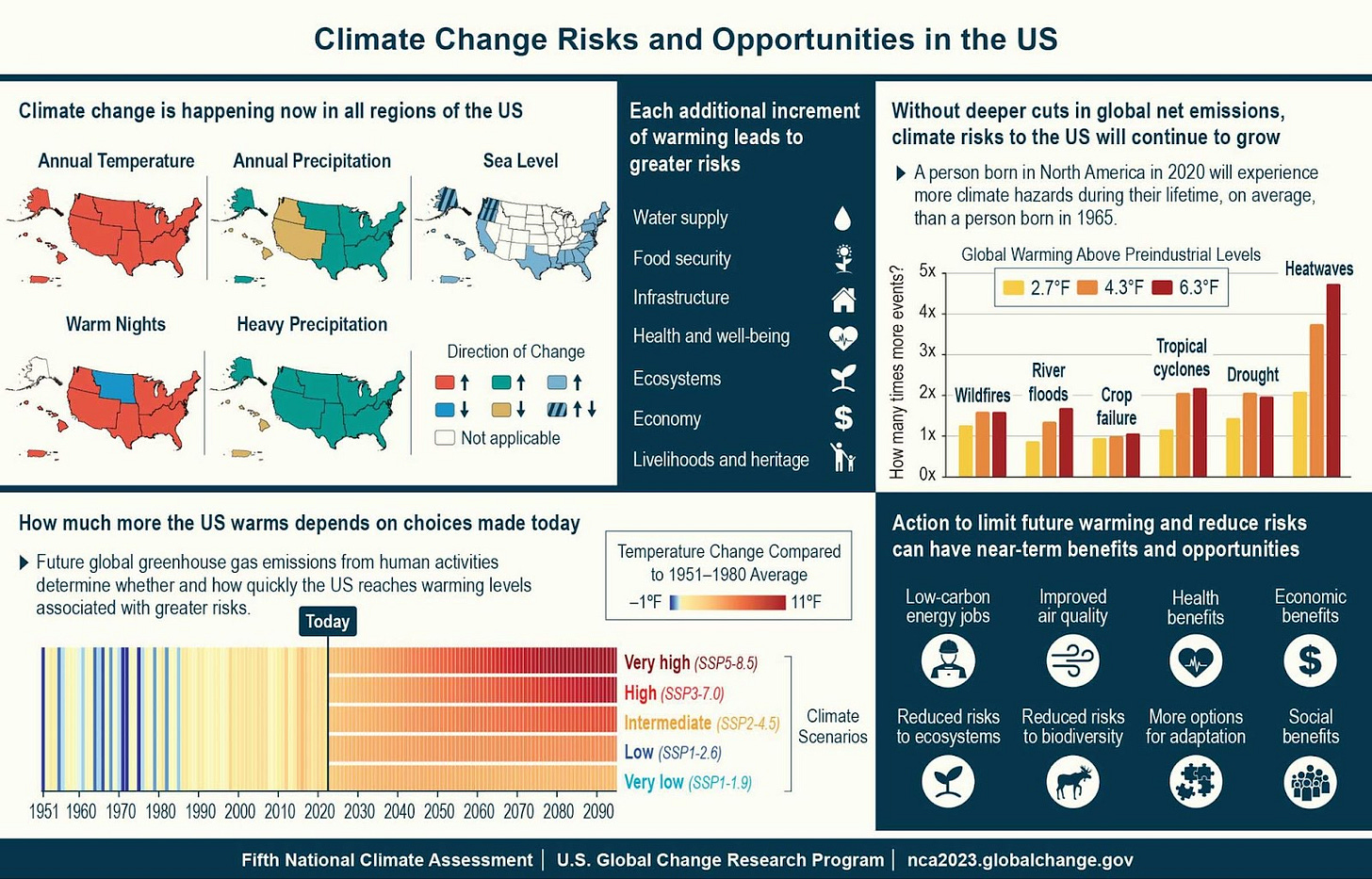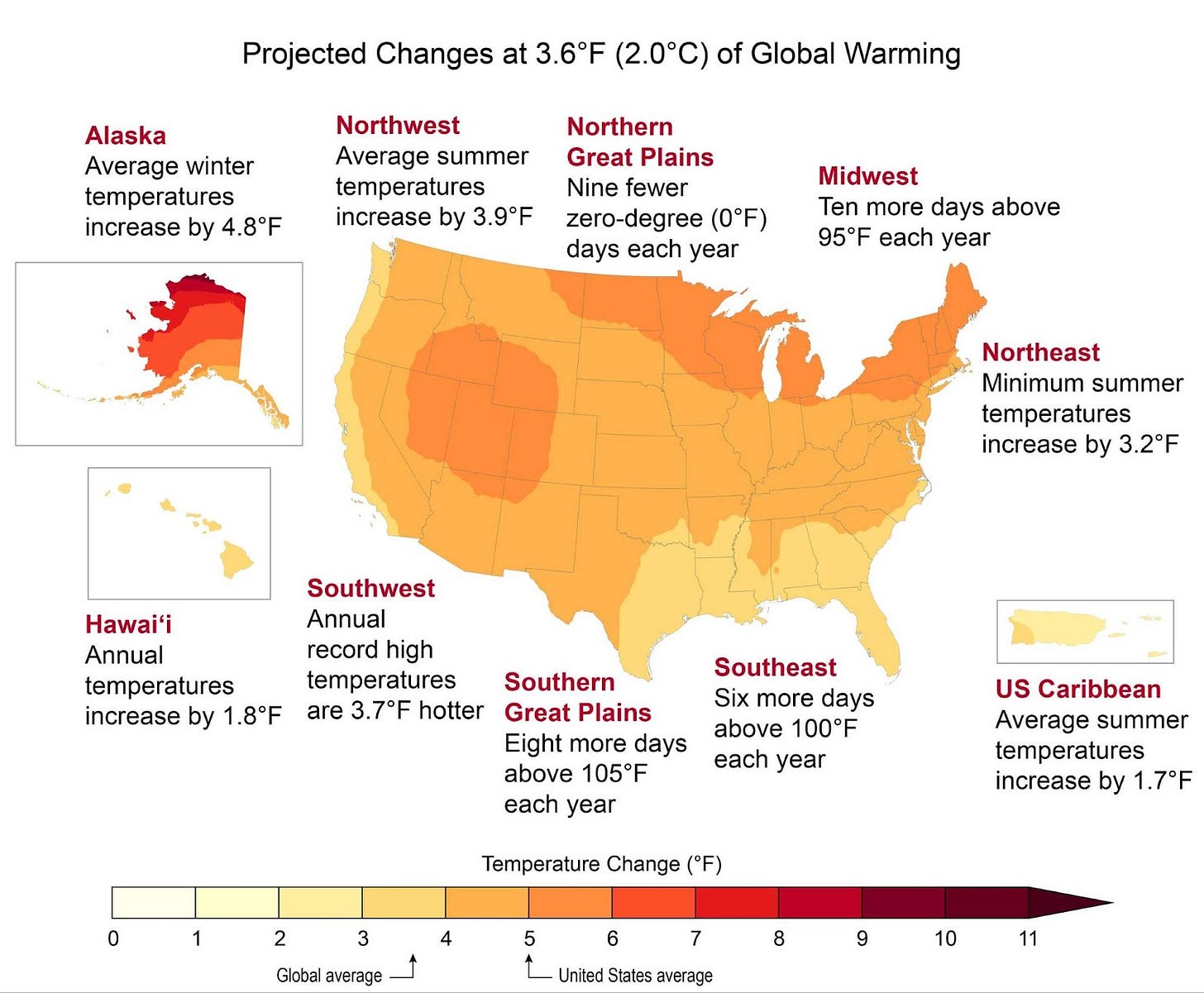Last Week in Collapse: November 12-18, 2023
The world slips further into fragmentation, pollution, and conflict. A planet divided against itself cannot stand.
Last Week in Collapse: November 12-18, 2023
This is Last Week in Collapse, a weekly newsletter bringing together some of the most important, timely, useful, soul-crushing, ironic, astounding, or otherwise must-see/can’t-look-away moments in Collapse. This week is a tough one.
This is the 99th newsletter. You can find the November 5-11 edition here on Reddit if you missed it last week. Thank you for subscribing to the Substack.
In Memoriam:
The U.S. Fish and Wildlife Service has declared 21 formally endangered species to be extinct. The full list, which was actually released last month, includes 10 birds, 1 bat, 2 fish, and 8 freshwater mussels.
The U.S. government released its Fifth National Climate Assessment last week, although the full report and all chapters except the first are “coming soon.” For now, there is only a 144-page “Report-in-Brief and the first chapter, a 47-page overview of the predicament. The report predicts a sea level rise of almost one foot (.3 meters) by 2050, and models the impacts that different temperature increases will have on the landscape. The overall conclusions are already well-known in this community, but the many visualizations are well worth checking out. The U.S. is warming faster than most of the rest of the world.
The Arctic is warming 4x faster than the rest of the world, a result of Arctic/Polar Amplification. This phenomenon is bringing us closer to 2 °C—by 8 years. Faster than expected. The related phenomenon of “committed warming” shows us that warming will continue even after emissions slow down or stop, because it takes time for a “thermal balance” to level out. The 1.5 °C warming limit called for in the Paris Agreement of 2015 is expected to be broken later this decade, so people are putting their hope in COPout28, the climate conference starting later this month in the notoriously unsustainable city of Dubai.
The world’s largest wetland, Brazil’s Pantanal, saw record numbers of fires. We know that local fires have global impacts. One third of the world’s forests are harvested for timber, and climate change & wildfires are increasing in severity and scope. Another study claimed that colossal carbon emissions—equivalent to decades of U.S. emissions—could be sequestered in future old growth forests and reforesting recently cleared tracts.
Autumn is the new summer. Water scarcity in South Asia. Climate change may increase snowfall in the French Alps. Pollution and deforestation must be drastically reduced if we want to prevent the worst effects of climate change.
An interesting comparison of images of plant hardiness zones in Vermont, USA, shows the changes in hardiness grow zones over the last 15 years. The U.S. Department of Agriculture updated the plant hardiness grow maps from 2012, and the difference, for some states, is noticeable.
A study into weather has concluded that “climate hazard flip” is becoming more common. This is a term, also called “climate whiplash,” that refers to alternating patterns of drought & flood which have been devastating regions in hitherto unpredictable ways.
Another study confirms an inevitable truth: the West Antarctic Ice Sheet—WAIS—is on borrowed time, and scientists expect it to disappear if temperatures breach 2 °C warming. It is already melting, slowly threatening a sea level rise of 5.3m (17 feet) if when all the WAIS glaciers melt. Meanwhile, before-and-after photos of Greenland’s glaciers illustrate the scale of melt seen over the past ~90 years.
Officials who met in Nairobi are finalizing a draft text on a plastics and pollution treaty, expected to be signed and entered into force by 2025. India is considering cloud-seeding** to combat the toxic smog** hanging over Delhi; farmers are also ignoring government orders not to burn stuff on their fields. Rio hit an all-time high temperature for this year: a heat index of 58.5 °C (137 °F).
The Lancet released its 8th edition of its Countdown on Health and Climate Change, a visualization of how climate change will impact human health, global temperatures, disease spread, and food (in)security. I didn’t have the mental bandwidth to process it, but you can explore the 49-page report here if you’d like.
Drought in northern Italy is being compared to Ethiopia’s drought. Flooding in Libya displaced migrants. At least 10 people died from flooding in Tanzania. An unseasonably early snowstorm buried Anchorage, Alaska. Widespread wildfires in Australia burn, the most serious in decades. The EU has passed a law forbidding environmental damage “comparable to ecocide.”
The UN claims that dust & sand pollution is degrading about 1M square kilometers (100M hectares) of productive land every year. This is equivalent to about one and a half Madagascars every year… Is this statistic too outrageous to be believed, or is our situation that dire? Wait, don’t answer that.
——————————
Valley fever is becoming more common in the U.S. as the temperature increases, infecting tens of thousands of people per year—potentially many more. The UN has called loneliness a threat to global health.
As the Panama Canal continues to limit the number of cargo ships that may transit through, Canada’s Northwest Passage is seeing more traffic now that the ice is melting and extending the navigable season. Overall, the WTO is reducing its global trade forecast for next year, although they still expect trade volume to increase on balance.
A number of African currencies are depreciating compared with the US Dollar, and efforts to stabilize them are failing. As the currencies fall in value, imports drop because fewer people can afford things. Without certain imports, production levels also drop, perpetuating an old feedback loop.
The IMF is slowly pushing for digital currencies to replace cash. More than half the countries on earth are supposedly looking into this option. Moody’s is reconsidering its rating of the U.S. as a result of growing political polarization. When Trump was elected in 2016, the stock market suddenly boomed; will a second Trump victory send the markets crashing down?
Despite the United States’ $60 price cap imposed on Russian oil, almost all Russian oil exports are circumventing the cap. Now the U.S. is adding Russian LNG to its sanctions. Experts are putting their faith in solar energy for the world’s poorer countries.
A temporary copper surplus is momentarily pushing copper prices down. Microplastics in clouds may alter our weather patterns. An 8-page report from the U.S. EPA indicates that, in the last 5 years, 60M pounds of PFAS (27,000+ metric tonnes) was disposed of in ways that are likely to harm the environment. “These data show that we are steadily poisoning ourselves, our waters, and our food chain with extremely persistent toxic chemicals,” a former EPA lawyer said. Experts believe the figure is grossly undercounted.
Psychological troubles are becoming more widespread in Argentina. Thousands of protestors marched in Honduras against their President. Demand for prepping supplies in the UK is rising.
American public transportation is still not at pre-COVID levels. Large-scale absences from school still linger from the COVID lockdowns, with all the attendant societal consequences. It may or may not surprise you to hear that many people have suffered financially from COVID, despite an overall increase in average net worth (credited to the rich getting richer). The disparity between the lifespan of American men and women is now about 6 years, the widest difference measured in decades.
Over 95% of Gaza lacks clean water, making it a breeding ground for typhoid and cholera. Tents of thousands of cases of other diseases—lice, diarrhea, scabies, chickenpox, etc—have been documented, and the lack of clean water is also impacting emergency medical procedures. Not to mention growing hunger and endless electricity outages. If you were living in Gaza, and had prepped a bunch of supplies, how would you act in these circumstances?
The healthcare system in Sudan has also collapsed as a result of their ongoing war, where cholera has surged. Half the population (total pop: 47M) has been forced into a growing humanitarian crisis.
Teachers are apparently the career at greatest risk of Long COVID, alongside social workers. Despite years of research into Long COVID, patients’ outcomes are similar to where they were in 2020. Some scientists claim that Long COVID is just a rebrand of an old diagnosis: “chronic fatigue syndrome,” an illness that can be triggered by several diseases, including COVID. I fell rather sick this week with many of the symptoms of COVID, but tested negative several times…Can we trust our over-the-counter COVID tests?
The Guardian has compiled 10 ways that climate change creates a “health emergency”: 1) floods & disease, 2) mosquitoes, 3) human-animal contact, 4) extreme weather, 5) polluted air, 6) psychological fallout, 7) salty water and its impacts, 8) food insecurity, 9) extreme heat stress, and 10) (tens of) millions of displaced people. Which do you think is the most serious danger?
Keep reading with a 7-day free trial
Subscribe to Last Week in Collapse to keep reading this post and get 7 days of free access to the full post archives.













